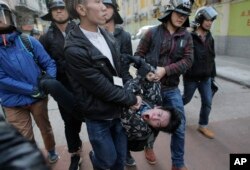Riot police used batons and pepper spray early Tuesday to disperse crowds after clashes erupted when authorities tried to move illegal street vendors from a working-class district, the worst street violence since pro-democracy protests in late 2014.
Protesters hurled bricks at police as scuffles broke out, while other demonstrators set fire to rubbish bins in the streets of Mong Kok, a gritty neighborhood across the harbor from the heart of the Asian financial center.
Police fired two shots into the air, a police spokeswoman said, amid chaotic scenes. Rubbish bins, chunks of brick and broken bottles lay scattered along the world-famous Nathan Road shopping strip Tuesday morning.
About 40 police vans were parked nearby.
The clashes broke out after police moved in to clear "hawkers," or illegal vendors, who sell local delicacies, trinkets and household goods from makeshift streetside stalls.
The hawkers, long a common sight on Hong Kong's bustling streets, quickly attracted a strong social media following under the hashtag #FishballRevolution.
"To ensure public safety and public order, police took resolute actions, including using baton and pepper spray, to stop the unlawful violent acts," police said in a statement.
The protesters had dispersed by 0000 GMT. More than 100 confronted police in a tense standoff hours before on the Chinese New Year holiday, when most of the city is shut down, with rubbish bins and flower pots in flames nearby.
Vows to keep fighting
Police told Reuters they were awaiting orders about security plans for Tuesday night.
"This is not the first time there has been violence in Mong Kok," said Paul Lee, a 65-year-old security guard. "I am deeply disappointed in the government."
The underground train station for Mong Kok, a bustling shopping district packed with street markets, shops and high-rise residential buildings, was closed temporarily.
A police statement said three men aged 27 to 35 were arrested for assaulting a police officer and obstructing police, while three police officers received hospital treatment.
Broadcaster RTHK said later that 24 people had been arrested.
The narrow streets in and around Mong Kok were the scene of some of the most violent clashes during protests in late 2014 to demand greater democracy in the former British colony that returned to Beijing rule in 1997.
Hong Kong Indigenous, a localist group that is fielding a candidate in a Legislative Council by-election in a few weeks, was involved in the protest, the South China Morning Post newspaper reported.
WATCH: Video footage of Hong Kong protests
Street tensions appeared to have eased off, but radical protesters and "localists" demanding greater Hong Kong autonomy have vowed to keep fighting even as China shows signs of tightening its grip.
The clashes in December 2014 came when authorities cleared the last of pro-democracy demonstrators from the streets after more than two months of occasionally violent protests that had posed one of the Beijing's greatest political challenges in decades.














